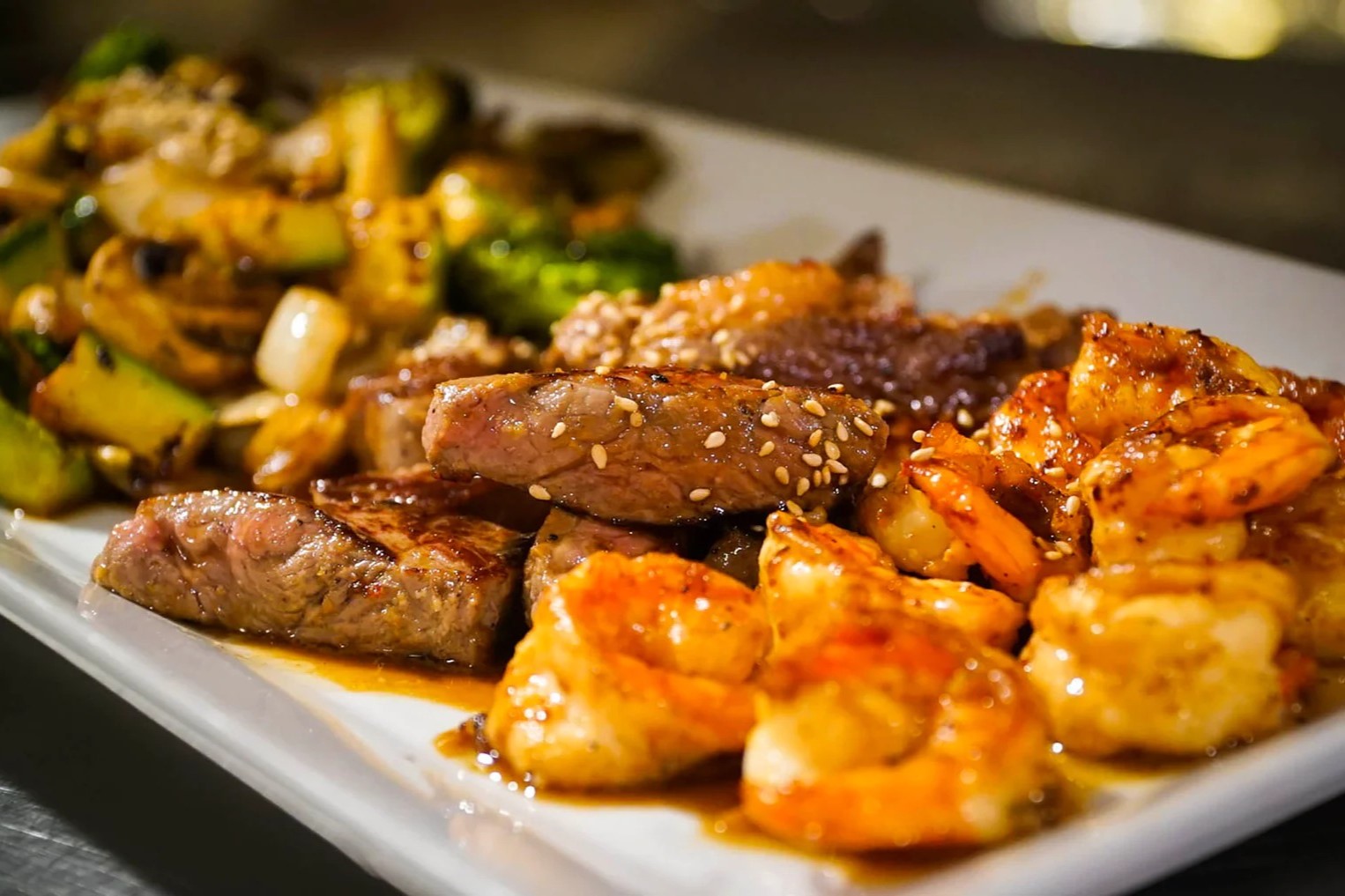
When it comes to dining out, Japanese steakhouses have become increasingly popular due to their unique dining experience and delicious cuisine. These establishments offer a combination of traditional Japanese cooking techniques with modern flair, and one of the highlights of their menus is the mouth-watering steaks they serve.
But if you’re conscious about your health and watching your calorie intake, you may be wondering about the nutritional value of the dishes served at Japanese steakhouses. Are they as healthy as they are delicious?
In this article, we will delve into the world of Japanese steakhouse nutrition and explore 19 popular dishes along with their nutritional facts. From miso soup and sushi rolls to hibachi-grilled meats and vegetable stir-fries, we will provide you with a comprehensive breakdown of the calories, fat content, protein, carbohydrates, and other essential nutrients found in these delectable dishes. So, get ready to satisfy your palate without compromising on your health!
Key Takeaways:
- Japanese steakhouse meals offer a variety of nutritious options, including high protein, healthy fats, and fresh ingredients, making it a great choice for a balanced and satisfying meal.
- With customizable dishes and mindful eating practices, Japanese steakhouse meals cater to diverse dietary needs while promoting social dining experiences and overall well-being.
Japanese Steakhouse Meals are Often High in Protein
Japanese steakhouse meals are known for their generous portions of protein-rich foods. These meals typically include high-quality cuts of meat such as steak, chicken, and seafood. These proteins are not only delicious but also provide essential amino acids that are important for building and repairing tissues in our bodies.
Japanese Steakhouse Meals Contain Healthy Fats
While Japanese steakhouse meals are often associated with meat, they also incorporate healthy fats from ingredients like avocado, sesame oil, and nuts. These fats are a great source of energy and support various bodily functions, including hormone production and nutrient absorption.
Japanese Steakhouse Meals are Rich in Vitamins and Minerals
Japanese steakhouse meals are typically served with a variety of vegetables, which are excellent sources of essential vitamins and minerals. From vitamin A in carrots to vitamin C in bell peppers, these nutrient-rich additions enhance the overall nutritional value of the meal.
Japanese Steakhouse Meals Include Fiber-rich Foods
Japanese steakhouse meals often feature fiber-rich foods like brown rice and stir-fried vegetables. Fiber is crucial for maintaining a healthy digestive system, promoting feelings of fullness, and regulating blood sugar levels.
Japanese Steakhouse Meals Contain Low Sodium Options
For those watching their sodium intake, Japanese steakhouse meals offer a range of low-sodium options. Dishes like miso soup, which is rich in umami flavor, are low in sodium and provide a satisfying start to the meal.
Japanese Steakhouse Meals Offer Gluten-free Choices
Japanese cuisine includes gluten-free options such as sushi rolls made with rice and fresh seafood. This makes Japanese steakhouse meals a suitable choice for individuals with gluten sensitivities or those following a gluten-free diet.
Japanese Steakhouse Meals Can Be Packed with Fresh Seafood
Japanese steakhouse meals often highlight the abundance of fresh seafood. From succulent shrimp to delicate salmon, incorporating seafood into these meals adds essential omega-3 fatty acids, which are beneficial for heart health.
Japanese Steakhouse Meals Promote Healthy Cooking Techniques
Japanese cooking techniques, such as grilling or teppanyaki, involve less oil and ensure that the natural flavors of the ingredients shine through. This promotes healthier eating without compromising on taste.
Japanese Steakhouse Meals Often Include Fermented Foods
Fermented foods like miso and soy sauce commonly accompany a Japanese steakhouse meal. These foods contain probiotics, which are beneficial for gut health and overall well-being.
Japanese Steakhouse Meals Incorporate Fresh Herbs and Spices
Japanese cuisine uses a variety of fresh herbs and spices to enhance the flavors of dishes. Ginger, garlic, and green onions not only add a delightful taste but also offer potential health benefits such as anti-inflammatory properties.
Japanese Steakhouse Meals Emphasize Fresh Ingredients
Japanese steakhouse meals prioritize the use of fresh ingredients to ensure the highest quality and nutritional value. This focus on freshness contributes to the overall healthiness of the meal.
Japanese Steakhouse Meals Offer Vegetarian and Vegan Options
Japanese cuisine provides a wide range of vegetarian and vegan options in the form of vegetable stir-fries, tofu-based dishes, and sushi rolls with various plant-based fillings. This allows individuals following these dietary preferences to enjoy a satisfying meal.
Japanese Steakhouse Meals Promote Mindful Eating
The traditional Japanese dining experience encourages mindful eating by emphasizing the presentation and flavors of each dish. This approach helps to cultivate a greater appreciation for the food and encourages slower, more conscious eating habits.
Japanese Steakhouse Meals Can Be Customized to Dietary Needs
Japanese steakhouse meals can often be customized according to specific dietary needs or preferences. Whether it’s requesting a lower sodium soy sauce or opting for extra vegetables, these meals can be tailored to suit individual requirements.
Japanese Steakhouse Meals Are Typically Low in Added Sugars
Unlike many other cuisines, Japanese steakhouse meals typically contain minimal added sugars. This makes them suitable for individuals looking to reduce their sugar intake or follow a low-sugar diet.
Japanese Steakhouse Meals Promote Balanced Eating
Japanese cuisine places importance on a balanced meal, incorporating a variety of food groups. From protein to whole grains and vegetables, Japanese steakhouse meals provide a well-rounded nutritional profile.
Japanese Steakhouse Meals Offer a Sweet Ending
Japanese steakhouse meals often end with a serving of fresh fruit or a light and refreshing dessert like green tea ice cream. These options provide a sweet ending without excessive added sugars or unhealthy fats.
Japanese Steakhouse Meals Can Cater to All Age Groups
Japanese steakhouse meals are versatile and can be enjoyed by people of all age groups. Whether it’s families with young children or older adults, there are options available to suit everyone’s tastes and dietary needs.
Japanese Steakhouse Meals Promote Social Dining
Japanese steakhouse dining is often a communal experience, with multiple people sharing a table and enjoying the meal together. This promotes a sense of camaraderie and fosters positive social connections while savoring the flavorful cuisine.
Conclusion
When dining at a Japanese steakhouse, it’s important to be mindful of your nutritional intake. While these establishments offer a unique and delicious dining experience, many of the menu items can be high in calories, sodium, and unhealthy fats. However, by making informed choices and opting for healthier options, you can still enjoy a tasty meal at a Japanese steakhouse without compromising your health.
Remember to prioritize lean protein sources, such as grilled chicken or fish, and load up on vegetables to increase your fiber intake. Steer clear of fried or tempura dishes, and choose steamed or grilled options instead. Additionally, be mindful of portion sizes and consider sharing dishes with your dining companions.
By paying attention to your choices and making small adjustments, you can enjoy the unique flavors of a Japanese steakhouse while maintaining a balanced and nutritious diet.
FAQs
1. Are Japanese steakhouses a healthy dining option?
While Japanese steakhouses offer a variety of grilled and fresh dishes, some menu items may be high in calories, sodium, and unhealthy fats. It’s important to make mindful choices and opt for healthier options, such as lean proteins and vegetables.
2. What are some healthier choices to make at a Japanese steakhouse?
Choose grilled chicken or fish as your protein source, and load up on vegetables like broccoli, mushrooms, and bell peppers. Avoid fried or tempura dishes, and opt for steamed or grilled options instead.
3. How can I control my portion sizes at a Japanese steakhouse?
Consider sharing dishes with your dining companions or asking for a takeout container at the beginning of your meal. This way, you can portion out your meal and save the leftovers for another time.
4. Are there any vegetarian or vegan options available at Japanese steakhouses?
While most Japanese steakhouses focus on meat and seafood, they usually offer vegetable-centric dishes like stir-fried or grilled vegetables, tofu, and vegetable sushi rolls. It’s always best to check with the restaurant in advance to ensure they can accommodate your dietary preferences.
5. Can I still enjoy the experience of a Japanese steakhouse while maintaining a healthy diet?
Absolutely! By making informed choices, such as opting for lean proteins, loading up on vegetables, and controlling portion sizes, you can still savor the flavors of a Japanese steakhouse without compromising your health.
Was this page helpful?
Our commitment to delivering trustworthy and engaging content is at the heart of what we do. Each fact on our site is contributed by real users like you, bringing a wealth of diverse insights and information. To ensure the highest standards of accuracy and reliability, our dedicated editors meticulously review each submission. This process guarantees that the facts we share are not only fascinating but also credible. Trust in our commitment to quality and authenticity as you explore and learn with us.


